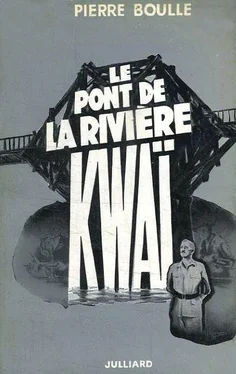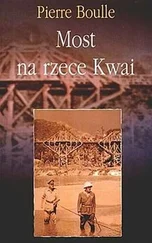It is quite a simple job to loosen the gravel which is used as ballast on a railway line from either side of the rails and from underneath them, so as to make a small cavity capable of holding a plastic charge fastened to the inside of the rails. The properties of this chemical compound are such that a two-pound charge, if cleverly placed, is all that is needed. The energy stored in that small amount is rapidly released, by the action of a detonator, in the form of a gas which reaches a speed of several thousand feet per second. The strongest steel is incapable of standing up to the splintering effect of this sudden expansion.
The detonator, then, is inserted in the plastic. (Pressing it in is as easy as sliding a knife through a pat of butter.) A length of so-called “instantaneous” fuse connects it to a wonderfully simple little mechanism which is likewise hidden in a hole made underneath the rail. This device consists of two blades kept apart by a strong spring, with a primer inserted between them. One of the blades is placed against the metal, while the other is firmly wedged with a stone. The detonating cord itself is buried below the surface. A team of two experts can lay this charge in less than half an hour. If the work is done carefully, the trap is invisible.
When one of the wheels of the engine presses down on the mechanism, the two blades are crushed together. The primer then sets off the detonator through the action of the instantaneous cord. The plastic explodes. A length of steel is reduced to powder. The train is derailed. With a little luck and with a slightly larger charge, the engine can be overturned. One of the advantages of this method is that the mechanism is released by the train itself, thus enabling the agent who has laid it to be a mile or more away at the time. Another is that it cannot go off prematurely if an animal treads on it. A really heavy weight, like a locomotive or a railroad car, is needed.
Warden, in his logical, systematic way, pursued the following argument: the first train will come from Bangkok along the right bank and so, in theory, will be blown up at the same time as the bridge and crash into the river. So much for target number one. The line is consequently cut, and traffic comes to a standstill. The Japanese then work like fiends to repair the damage. They are anxious to repair it as quickly as possible in order to open up the line again and avenge this outrage, which is also a serious blow to their prestige. They rush forward any amount of labor gangs and work without stopping. They toil away for days, for weeks, perhaps even for months. When the line is at last cleared, and the bridge rebuilt, another convoy comes along. This time the bridge holds together. But a little later—the next train to cross blows up. That is bound to cause an adverse psychological effect, apart from material damage. Warden lays a slightly larger charge than is strictly necessary, and places it so that the train will come off the rails close to the river bank. If all goes well, the engine and some of the coaches will land in the water.
Warden quickly completed these initial stages of his work. He was a past master at this sort of job, having trained himself to shift the gravel without making a sound before molding the plastic and setting the booby trap. He operated almost mechanically, and was pleased to find that the Siamese partisan, though new to the game, was nevertheless an able assistant. His instruction had been good—much to the delight of Professor Warden. There was still some time to go before daylight. He had brought with him a second contraption of the same type but slightly different, which he placed a few hundred yards further up the line in the opposite direction to the bridge. It would be criminal not to take full advantage of a night like this.
Warden had shown his usual foresight. After two attacks in the same sector the enemy usually got suspicious and proceeded to inspect the line systematically. But one never knew. Sometimes, on the contrary, he could not imagine the possibility of a third outrage, precisely because there had already been two. In any case, if the trap was well camouflaged, it might escape the most searching scrutiny—unless the search party reluctantly decided to rake through every bit of gravel in the ballast. Warden set his second “toy,” which differed from the first in that it was fitted with a device to vary the effects of the explosion and cause another sort of alarm. The mechanism worked on a kind of delayed-action principle. The first train did not set it off, but simply started the mechanism working. The detonator and plastic them^ selves were only affected by the weight of the following train. It was quite clear what the Force 316 technicians had in mind when they perfected this ingenious device which so delighted Warden’s rational mentality. Quite often, when a line had been repaired after a whole series of accidents, the enemy sent the next important convoy through behind a screen of a couple of coaches loaded with stones and pulled by a useless old engine. Nothing untoward happened to the leading train. And so the enemy was convinced that his run of bad luck was over. Full of confidence, and without any further security measure, he launched the train that really mattered, and presto, the train that really mattered blew up!
“Never assume an operation is complete unless the enemy has been caused as much alarm and despondency as possible” was the leitmotif of the Plastic and Destructions Company, Ltd. “Always strive to multiply the number of unpleasant surprises and to invent fresh traps so as to sow confusion among the enemy just when he thinks he has at last been left in peace” was the firm’s ceaseless exhortation. Warden had taken these doctrines to heart. After setting his second trap and leaving no trace of it, he again racked his brains and tried to think of yet another trick to play.
He had brought with him a few other “toys,” just in case. He had several specimens of one of these, consisting of a round of ammunition fitted into a loose board which pivoted on its axis and snapped back onto a second, fixed, board pierced with a nail. These were antipersonnel devices. They were hidden under a thin layer of earth. They were the most simple sort of mechanism imaginable. The weight of one man was all that was needed to snap the round down onto the firing pin. The bullet went off and pierced the man’s foot or, with any luck, hit him in the forehead, if he happened to be walking leaning forward. The instructors in the special school in Calcutta recommended scattering large numbers of these “toys” in the neighborhood of a “prepared” railway line. After the explosion, with the survivors (there were bound to be a few) rushing about in panic, the traps would go off and add to their confusion.
Warden would have liked to get rid of the whole lot as cunningly as possible, but his caution and reason prompted him to abandon this final delight. There was a risk of their being discovered, and the priority target was too important to warrant such a risk. A sentry coming across one of these traps would be enough to put the Japs on their guard against a possible sabotage attack.
Dawn was approaching. Warden wisely but reluctantly decided to go no further and started back for the observation post. He was fairly pleased to be leaving behind him a well-prepared area seasoned with spices designed to give an added zest to the main attack.
One of the partisans made a sudden movement. He had heard an unusual crackling in the forest of giant ferns which covered the hilltop. For a few seconds the four Siamese kept absolutely still. Warden had seized his Tommy gun and stood ready for any eventuality. Three low whistles were heard a little below them. One of the Siamese whistled back, then waved his arm and turned to Warden.
Читать дальше











